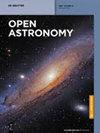An orbit determination method of spacecraft based on distribution regression
IF 0.5
4区 物理与天体物理
Q4 ASTRONOMY & ASTROPHYSICS
引用次数: 2
Abstract
Abstract A new method of orbit determination (OD) is proposed: distribution regression. The paper focuses on the process of using sparse observation data to determine the orbit of the spacecraft without any prior information. The standard regression process is to learn a map from real numbers to real numbers, but the approach put forward in this paper is to map from probability distributions to real-valued responses. According to the new algorithm, the number of orbital elements can be predicted by embedding the probability distribution into the reproducing kernel Hilbert space. While making full use of the edge of big data, it also avoids the problem that the algorithm cannot converge due to improper initial values in precise OD. The simulation experiment proves the effectiveness, robustness, and rapidity of the algorithm in the presence of noise in the measurement data.基于分布回归的航天器定轨方法
摘要提出了一种新的定轨方法:分布回归法。本文重点介绍了在没有任何先验信息的情况下,利用稀疏观测数据确定航天器轨道的过程。标准的回归过程是学习从实数到实数的映射,但本文提出的方法是从概率分布到实数响应的映射。根据新算法,可以通过将概率分布嵌入再现核希尔伯特空间来预测轨道元素的数量。在充分利用大数据边缘的同时,也避免了算法在精确OD中由于初始值不合适而无法收敛的问题。仿真实验证明了该算法在测量数据中存在噪声的情况下的有效性、鲁棒性和快速性。
本文章由计算机程序翻译,如有差异,请以英文原文为准。
求助全文
约1分钟内获得全文
求助全文
来源期刊

Open Astronomy
Physics and Astronomy-Astronomy and Astrophysics
CiteScore
1.30
自引率
14.30%
发文量
37
审稿时长
16 weeks
期刊介绍:
The journal disseminates research in both observational and theoretical astronomy, astrophysics, solar physics, cosmology, galactic and extragalactic astronomy, high energy particles physics, planetary science, space science and astronomy-related astrobiology, presenting as well the surveys dedicated to astronomical history and education.
 求助内容:
求助内容: 应助结果提醒方式:
应助结果提醒方式:


